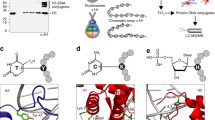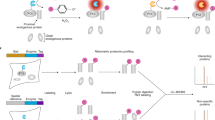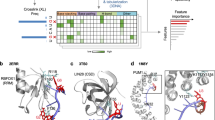Abstract
Hydroxyl radical footprinting has been widely used for studying the structure of DNA and DNA–protein complexes. The high reactivity and lack of base specificity of the hydroxyl radical makes it an excellent probe for high-resolution footprinting of DNA–protein complexes; this technique can provide structural detail that is not achievable using DNase I footprinting. Hydroxyl radical footprinting experiments can be carried out using readily available and inexpensive reagents and lab equipment. This method involves using the hydroxyl radical to cleave a nucleic acid molecule that is bound to a protein, followed by separating the cleavage products on a denaturing electrophoresis gel to identify the protein-binding sites on the nucleic acid molecule. We describe a protocol for hydroxyl radical footprinting of DNA–protein complexes, along with a troubleshooting guide, that allows researchers to obtain efficient cleavage of DNA in the presence and absence of proteins. This protocol can be completed in 2 d.
This is a preview of subscription content, access via your institution
Access options
Subscribe to this journal
Receive 12 print issues and online access
$259.00 per year
only $21.58 per issue
Buy this article
- Purchase on Springer Link
- Instant access to full article PDF
Prices may be subject to local taxes which are calculated during checkout




Similar content being viewed by others
References
Tullius, T.D. Physical studies of protein-DNA complexes by footprinting. Annu. Rev. Biophys. Biophys. Chem. 18, 213–237 (1989).
Hampshire, A.J., Rusling, D.A., Broughton-Head, V.J. & Fox, K.R. Footprinting: a method for determining the sequence selectivity, affinity and kinetics of DNA-binding ligands. Methods 42, 128–140 (2007).
Adilakshmi, T., Lease, R.A. & Woodson, S.A. Hydroxyl radical footprinting in vivo: mapping macromolecular structures with synchrotron radiation. Nucleic Acids Res. 34, e64 (2006).
Urbach, A.R. & Waring, M.J. Visualising DNA: footprinting and 1-2D gels. Mol. BioSyst. 1, 287–293 (2005).
Galas, D.J. & Schmitz, A. DNase footprinting: a simple method for the detection of protein-DNA binding specificity. Nucleic Acids Res. 5, 3157–3170 (1978).
Brenowitz, M., Senear, D.F., Shea, M.A. & Ackers, G.K. Quantitative DNase footprint titration: a method for studying protein-DNA interactions. Meth. Enzymol. 130, 132–181 (1986).
Drew, H.R. & Travers, A.A. DNA structural variations in the E. coli tyrT promoter. Cell 37, 491–502 (1984).
Sawadogo, M. & Roeder, R.G. Interaction of a gene-specific transcription factor with the adenovirus major late promoter upstream of the TATA box region. Cell 43, 165–175 (1985).
Tullius, T.D., Dombroski, B.A., Churchill, M.E. & Kam, L. Hydroxyl radical footprinting: a high-resolution method for mapping protein-DNA contacts. Meth. Enzymol. 155, 537–558 (1987).
Tullius, T.D. & Dombroski, B.A. Hydroxyl radical 'footprinting': high-resolution information about DNA-protein contacts and application to Lambda repressor and Cro protein. Proc. Natl. Acad. Sci. USA 83, 5469–5473 (1986).
Tullius, T.D. DNA footprinting with hydroxyl radical. Nature 332, 663–664 (1988).
Pogozelski, W.K. & Tullius, T.D. Oxidative strand scission of nucleic acids: routes initiated by hydrogen abstraction from the sugar moiety. Chem. Rev. 98, 1089–1108 (1998).
Price, M.A. & Tullius, T.D. Using hydroxyl radical to probe DNA structure. Meth. Enzymol. 212, 194–219 (1992).
Price, M.A. & Tullius, T.D. How the structure of an adenine tract depends on sequence context: a new model for the structure of TnAn DNA sequences. Biochemistry 32, 127–136 (1993).
Ganunis, R.M., Guo, H. & Tullius, T.D. Effect of the crystallizing agent 2-methyl-2,4-pentanediol on the structure of adenine tract DNA in solution. Biochemistry 35, 13729–13732 (1996).
Churchill, M.E., Tullius, T.D., Kallenbach, N.R. & Seeman, N.C. Holliday recombination intermediate is twofold symmetric. Proc. Natl. Acad. Sci. USA 85, 4653–4656 (1988).
Tullius, T.D. & Greenbaum, J.A. Mapping nucleic acid structure by hydroxyl radical cleavage. Curr. Opin. Chem. Biol. 9, 127–134 (2005).
Churchill, M.E., Hayes, J.J. & Tullius, T.D. Detection of drug binding sites by hydroxyl radical footprinting. Relationship of distamycin binding to nucleosome positions on the 5S RNA gene of Xenopus. Biochemistry 29, 6043–6050 (1990).
Mah, S.C., Townsend, C.A. & Tullius, T.D. Hydroxyl radical footprinting of calicheamicin. Relationship of DNA binding to cleavage. Biochemistry 33, 614–621 (1994).
Tullius, T.D. & Dombroski, B.A. Iron(II) EDTA used to measure the helical twist along any DNA molecule. Science 230, 679–681 (1985).
Udenfriend, S., Clark, C.T., Axelrod, J. & Brodie, B.B. Ascorbic acid in aromatic hydroxylation. I. A model system for aromatic hydroxylation. J. Biol. Chem. 208, 731–740 (1954).
Fenton, H.J.H. Oxidation of tartaric acid in the presence of iron. J. Chem. Soc. 65, 899–910 (1894).
Shcherbakova, I., Mitra, S., Beer, R.H. & Brenowitz, M. Fast Fenton footprinting: a laboratory-based method for the time-resolved analysis of DNA, RNA and proteins. Nucleic Acids Res. 34, e48 (2006).
Shcherbakova, I. & Brenowitz, M. Monitoring structural changes in nucleic acids with single residue spatial and millisecond time resolution by quantitative hydroxyl radical footprinting. Nat. Protoc. 3, 288–302 (2008).
Hayes, J.J., Kam, L. & Tullius, T.D. Footprinting protein-DNA complexes with gamma-rays. Meth. Enzymol. 186, 545–549 (1990).
Ottinger, L.M. & Tullius, T.D. High-resolution in vivo footprinting of a protein-DNA complex using γ-radiation. J. Am. Chem. Soc. 122, 5901–5902 (2000).
Greenbaum, J.A., Pang, B. & Tullius, T.D. Construction of a genome-scale structural map at single-nucleotide resolution. Genome Res. 17, 947–953 (2007).
Greenbaum, J.A., Parker, S.C. & Tullius, T.D. Detection of DNA structural motifs in functional genomic elements. Genome Res. 17, 940–946 (2007).
Steitz, T.A. Structural studies of protein-nucleic acid interactions: the sources of sequence specific binding. Q. Rev. Biophys. 23, 205–280 (1990).
Pabo, C.O. & Sauer, R.T. Transcription factors: structural families and principles of DNA recognition. Annu. Rev. Biochem. 61, 1053–1095 (1992).
Carey, J. Gel retardation. Meth. Enzymol. 208, 103–117 (1991).
Lane, D., Prentki, P. & Chandler, M. Use of gel retardation to analyze protein-nucleic acid interactions. Microbiol. Rev. 56, 509–528 (1992).
Fried, M.G. Measurement of protein-DNA interaction parameters by electrophoresis mobility shift assay. Electrophoresis 10, 366–376 (1989).
Garner, M.M. & Revzin, A. The use of gel electrophoresis to detect and study nucleic acid-protein interactions. Trends Biochem. Sci. 11, 395–396 (1986).
Fried, M.G. & Crothers, D.M. Equilibria and kinetics of Lac repressor-operator interactions by polyacrylamide gel electrophoresis. Nucleic Acids Res. 9, 6505–6525 (1981).
Hellman, L.M. & Fried, M.G. Electrophoretic mobility shift assay (EMSA) for detecting protein-nucleic acid interactions. Nat. Protoc. 2, 1849–1861 (2007).
Woodbury, C.P. Jr. & von Hippel, P.H. On the determination of deoxyribonucleic acid-protein interaction parameters using the nitrocellulose filter-binding assay. Biochemistry 22, 4730–4737 (1983).
Nirenberg, M. & Leder, P. RNA codewords of protein synthesis. Science 145, 1399–1407 (1964).
Jones, O.W. & Berg, P. Studies on the binding of RNA polymerase to polynucleotides. J. Mol. Biol. 22, 199–209 (1966).
Yarus, M. & Berg, P. Recognition of tRNA by aminoacyl tRNA synthetases. J. Mol. Biol. 28, 479–490 (1967).
Vrana, K.E., Churchill, M.E., Tullius, T.D. & Brown, D.D. Mapping functional regions of transcription factor TFIIIA. Mol. Cell. Biol. 8, 1684–1696 (1988).
Hayes, J.J., Tullius, T.D. & Wolffe, A.P. The structure of DNA in a nucleosome. Proc. Natl. Acad. Sci. USA 87, 7405–7409 (1990).
Dixon, W.J., Inouye, C., Karin, M. & Tullius, T.D. CUP2 binds in a bipartite manner to upstream activation sequence c in the promoter of the yeast copper metallothionein gene. J. Biol. Inorg. Chem. 1, 451–459 (1996).
Jamison McDaniels, C.P., Jensen, L.T., Srinivasan, C., Winge, D.R. & Tullius, T.D. The yeast transcription factor Mac1 binds to DNA in a modular fashion. J. Biol. Chem. 274, 26962–26967 (1999).
Bashkin, J.S., Hayes, J.J., Tullius, T.D. & Wolffe, A.P. Structure of DNA in a nucleosome core at high salt concentration and at high temperature. Biochemistry 32, 1895–1898 (1993).
Widlund, H.R. et al. Nucleosome structural features and intrinsic properties of the TATAAACGCC repeat sequence. J. Biol. Chem. 274, 31847–31852 (1999).
Draganescu, A., Levin, J.R. & Tullius, T.D. Homeodomain proteins: what governs their ability to recognize specific DNA sequences? J. Mol. Biol. 250, 595–608 (1995).
Kimball, A.S., Milman, G. & Tullius, T.D. High-resolution footprints of the DNA-binding domain of Epstein-Barr virus nuclear antigen 1. Mol. Cell. Biol. 9, 2738–2742 (1989).
Danford, A.J., Wang, D., Wang, Q., Tullius, T.D. & Lippard, S.J. Platinum anticancer drug damage enforces a particular rotational setting of DNA in nucleosomes. Proc. Natl. Acad. Sci. USA 102, 12311–12316 (2005).
Draganescu, A. & Tullius, T.D. The DNA binding specificity of engrailed homeodomain. J. Mol. Biol. 276, 529–536 (1998).
Buchman, C., Skroch, P., Dixon, W.J., Tullius, T.D. & Karin, M. A single amino acid change in CUP2 alters its mode of DNA binding. Mol. Cell. Biol. 10, 4778–4787 (1990).
Kimball, A.S., Kimball, M.L., Jayaram, M. & Tullius, T.D. Chemical probe and missing nucleoside analysis of Flp recombinase bound to the recombination target sequence. Nucleic Acids Res. 23, 3009–3017 (1995).
Dixon, W.J. et al. Hydroxyl radical footprinting. Meth. Enzymol. 208, 380–413 (1991).
Lutter, L.C. Precise location of DNase I cutting sites in the nucleosome core determined by high resolution gel electrophoresis. Nucleic Acids Res. 6, 41–56 (1979).
Maxam, A.M. & Gilbert, W. Sequencing end-labeled DNA with base specific chemical cleavages. Meth. Enzymol. 65, 499–560 (1980).
Das, R., Laederach, A., Pearlman, S.M., Herschlag, D. & Altman, R.B. SAFA: semi-automated footprinting analysis software for high-throughput quantification of nucleic acid footprinting experiments. RNA 11, 344–354 (2005).
Current Protocols in Nucleic Acid Chemistry (ed. Harkins, E.W.) (John Wiley & Sons, Inc., Somerset, New Jersey, 2005).
Vinson, C.R., Sigler, P.B. & McKnight, S.L. Scissors-grip model for DNA recognition by a family of leucine zipper proteins. Science 246, 911–916 (1989).
Dixon, W.J. Determination of the protein-DNA interactions of two transcription activators, the yeast Copper Protein 2 and the human Growth Hormone Factor 1. DNA-binding models for the Copper "Fist" and POU domain. (Dissertation) (The Johns Hopkins University, Baltimore, Maryland, 1992).
Balasubramanian, B., Pogozelski, W.K. & Tullius, T.D. DNA strand breaking by the hydroxyl radical is governed by the accessible surface areas of the hydrogen atoms of the DNA backbone. Proc. Natl. Acad. Sci. USA 95, 9738–9743 (1998).
Shadle, S.E. et al. Quantitative analysis of electrophoresis data: novel curve fitting methodology and its application to the determination of protein-DNA binding constant. Nucleic Acids Res. 25, 850–860 (1997).
Acknowledgements
We thank Dr. Wendy Dixon for producing the CUP2 footprint shown in Figure 2.
Author information
Authors and Affiliations
Corresponding author
Rights and permissions
About this article
Cite this article
Jain, S., Tullius, T. Footprinting protein–DNA complexes using the hydroxyl radical. Nat Protoc 3, 1092–1100 (2008). https://doi.org/10.1038/nprot.2008.72
Published:
Issue Date:
DOI: https://doi.org/10.1038/nprot.2008.72
This article is cited by
-
Functionalizing DNA origami to investigate and interact with biological systems
Nature Reviews Materials (2022)
-
Guanidine- and purine-functionalized ligands of FeIIIZnII complexes: effects on the hydrolysis of DNA
JBIC Journal of Biological Inorganic Chemistry (2019)
-
Structural interpretation of DNA–protein hydroxyl-radical footprinting experiments with high resolution using HYDROID
Nature Protocols (2018)
-
Widespread bacterial lysine degradation proceeding via glutarate and L-2-hydroxyglutarate
Nature Communications (2018)
-
Single molecule high-throughput footprinting of small and large DNA ligands
Nature Communications (2017)
Comments
By submitting a comment you agree to abide by our Terms and Community Guidelines. If you find something abusive or that does not comply with our terms or guidelines please flag it as inappropriate.



